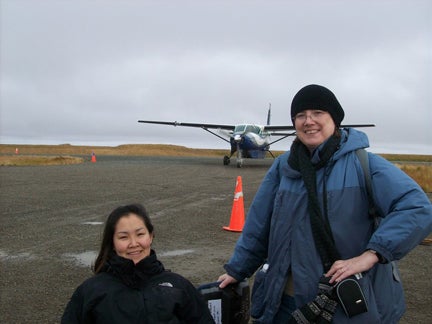On a winter morning, Alayna Eagle Shield, 24, rises early in her home on the Standing Rock Indian Reservation in North Dakota. She wakes her two children and readies them to embark on a long trek across the frozen prairie in search of dental care.
“In my community the only time we are seen by a dentist is when we stand in line before the sun comes up on Monday mornings…even then we are not guaranteed care,” she explains. “Since we cannot afford to get our teeth fixed in a big city, many of our youth grow up with missing teeth.”
Too many Native Americans like Alayna and her family go without dental care each year. This is especially true of Native American youth. Seventy-two percent of Native youth currently suffer from untreated tooth decay. As a result, they experience severe health problems that, when left untreated, can lead to life-threatening conditions like cardiovascular disease and diabetes.
Beyond the long-term health problems stemming from lack of access to care, there is the simple yet devastating issue of the pain. Littlebear Sanchez, 22, Mescalero Apache from New Mexico, described this problem recently in an op-ed: “Last year, as a result of poor access to dental care, I suffered in pain for many months with a broken, infected tooth. As the pain became unbearable, I even tried pulling the tooth out myself.”
The biggest obstacle to improving dental care in tribal communities is their remote location. The dentists that do come often leave soon after.
According to Health Resource Services Administration (HRSA), the primary federal agency tasked with improving access to health care, 77 percent of U.S. counties are designated as dental care shortage areas (a full list can be found here). This means there are simply not enough dentists to serve the population in a given geographic area. In some cases, there are no dentists at all. Native children are particularly hard hit by lack of dental care access. Utilizing HRSA’s data and the 2010 U.S. census information, the Center for Native American Youth determined that nearly 50 percent of the nation’s 2.1 million Native youth live in one of these dental care shortage areas.
Though this problem impacts nearly one million Native American children, it is not just a Native American problem. Low income populations and rural communities are similarly affected. Even if there is a dentist, data suggests that 80 percent don’t accept Medicaid as payment for services, meaning many people — even ones with a dentist in their community — are still left behind.
But the positive side of the story is in the U.S., Indian tribes have led the way in delivering life-changing care despite those challenges.
Ten years ago, the Alaska Native Tribal Health Consortium (ANTHC) and Alaska tribes looked at the oral health of rural communities and saw an alarming problem. Untreated dental decay was ravaging communities — some with rates of decay five times that of the general population. Communities that once had incredibly low rates of decay began seeing spikes in cavities due to the introduction of processed foods and other changes in diet.
Alaska tribes had attempted to improve oral health and attract dentists with lucrative employment packages and loan-payback models but those failed to bring dental providers to their remote communities. Learning from this shortfall, they sought a new way to bring care to remote villages. Eventually they landed on an evidence-based, tried and true method in existence for nearly a century: mid-level providers.
Alaska tribes dental health aide therapists (DHAT) — think of them as nurse practitioners or physician’s assistants, but for teeth — are part of a dentist-led team. While prevention through education is fundamental to the goal of DHATs, within their limited scope of practice, DHATs are able to safely treat active oral disease.
Unlike dentists, who are required to learn an expansive set of procedures, DHATs focus on a small number of the most common preventive care procedures and train extensively on those. They are thoroughly trained on pediatric care, which makes up sixty-percent of their work, and they learn motivational interviewing to better interact with families. Once they have finished more than 3,000 hours of training, including 400 hours of work alongside a dentist, DHATs continue their practice under the general supervision of a dentist. This means that they can work in off-site locations like small villages accessible only by plane while their supervising dentist is back at a regional clinic. This model means that the supervising dentist has more time to perform complicated, higher cost procedures while still having final say over all the work done by the DHATs.
As a result of this innovative program, instead of seeing a dentist every couple of years, if at all, Alaska Native communities have continuous care from DHATs who use airplanes, boats, and snowmobiles to reach their rural patients. For the first time in more than a hundred years, Alaska Native communities are seeing cavity-free children.
This cost-effective mid-level model has been part of health systems in more than 50 countries for a hundred years. In fact, the first Alaskan dental therapist class was educated in New Zealand, where dental therapists have practiced since 1921. Dental therapists are the most studied dental providers in the world. Regardless, Alaska continues to demonstrate the effectiveness and safety of mid-level providers through their 27 practicing DHATs.
Despite this success, the DHAT model is opposed at every turn by mainstream organized dentistry. In 2006, the American Dental Association (ADA) and the Alaska Dental Society unsuccessfully sued the tribal health consortium and each of the original practicing DHATs. While mid-level providers are now legally protected in Alaska, the ADA continues to block legislation establishing mid-level providers for low income communities in other states. As a result, those who are most at-risk are left without care and often take drastic measures, like Littlebear Sanchez’s effort to pull out his own tooth.


